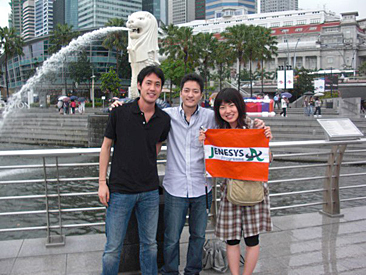| A Record of Singapore by Gen Nakatomi |
||||
| Contributed in August, 2010 I visited Singapore as a participant of the JENESYS Programme for 10 days from 16 to 25 March 2010. The experience in Singapore made a huge impact on me as well as motivated me for my future. When I arrived at Changi airport, I smelled a particular scent which seemed like a mixture of perfume and spices. I also talked to a group of Singaporean youth who were on the same plane. They were wearing uniforms with the words “Team Singapore” printed on their backs. They told me they were on their way to Japan to participate in a gymnastics competition as representative athletes of Singapore. The coach was a Chinese and he was offered the job from Singapore. At a glance, I saw different ethnic groups including Chinese, Indian and others in the team. The Chinese Singaporeans were speaking in Chinese with one another, whereas they spoke English to people from other races. At the airport, there were not only Chinese, Indians and Malays but I also saw Arab Muslims who covered their heads with scarves. Hence, my first impression of this multi-ethnic “scenery” startled me  We stayed in a hotel located along Orchard Road. I heard that Orchard Road is the heart of Singapore as well as the biggest shopping district. Indeed, it reminds me of Ginza in Tokyo where there are many huge buildings that accommodate big brand shops and where department stores lined the streets. I needed to walk further if I wanted to find a cheaper coffee shop or bar. Most people walking down the streets were mainly Chinese and I could hear the Chinese language being spoken frequently. However, advertisements were in English and shop staff also spoke in the English language. I learnt after the trip that most Singaporeans can speak “Singlish” as well as American or British English, depending on the situation. We stayed in a hotel located along Orchard Road. I heard that Orchard Road is the heart of Singapore as well as the biggest shopping district. Indeed, it reminds me of Ginza in Tokyo where there are many huge buildings that accommodate big brand shops and where department stores lined the streets. I needed to walk further if I wanted to find a cheaper coffee shop or bar. Most people walking down the streets were mainly Chinese and I could hear the Chinese language being spoken frequently. However, advertisements were in English and shop staff also spoke in the English language. I learnt after the trip that most Singaporeans can speak “Singlish” as well as American or British English, depending on the situation.
During our stay, we moved from place to place by bus to visit the various stops scheduled in the programme. The view from the bus window was to me, like a fusion of Manhattan and Central Park in New York. Commercial facilities with glass-walls lined up the town which looked green and “open”. We visited the Urban Redevelopment Agency (URA), a government agency which plans the development of Singapore. The development of the city is rapidly moving ahead under the orders of the Prime Minister in a top-down manner. I learnt that there are concrete plans to build some ten or twenty buildings in an area already undergoing development. From 20 to 21 March, we visited NUS and held discussions with the students regarding educational systems in both countries. We also went to Ubin Island for an overnight stay and enjoyed kayaking with our Singaporean friends. According to the students, they were taught in English from primary school and they would sit for “GCE” which is the same examination format used in England to enter university. I learnt this after the trip that Singapore was first under the East India Company of Britain and later on, Sir Stamford Raffles who devoted himself to develop Singapore in the 19th century. To honour this “founding father”, you can see his statues in the city and even an MRT station which is named after him -“Raffles Place”. I think the influence from the British colony still remains in Singapore’s educational system. Although it was a short stay in Singapore, I could bring back many souvenirs and memories. Personally, I was greatly shocked to learn the fact that “Japan is no longer Asia’s No. 1” from meeting Singaporean students, government officials and Mr. Terasawa from JETRO Singapore Office. The era of the economic giant Japan, trying to go over America and Europe has ended. I think we, Japanese, should learn tenacity and the positive spirit from Singapore and other Asian countries. By visiting foreign countries, learning from them and recognizing that we are behind global standards, I think that is the first step we can do to overcome our closeness, negativeness and pessimism. |
||||